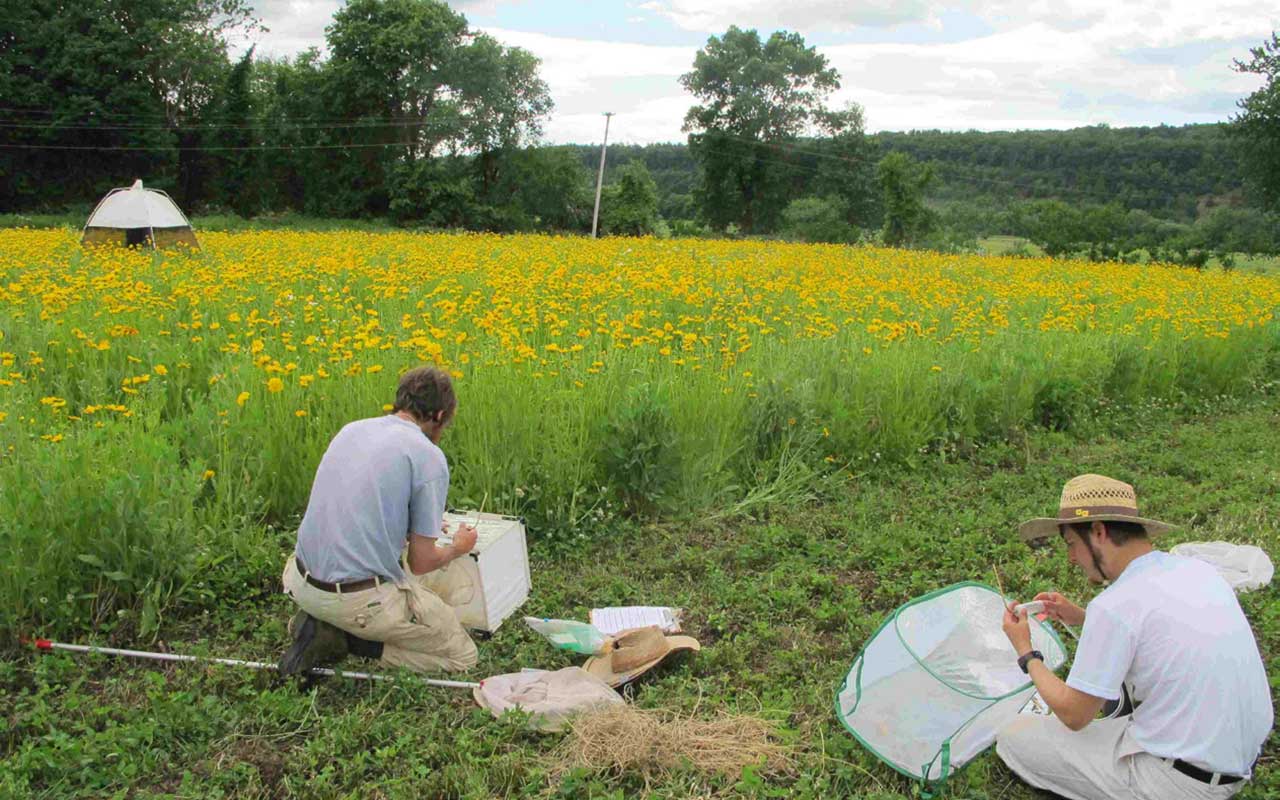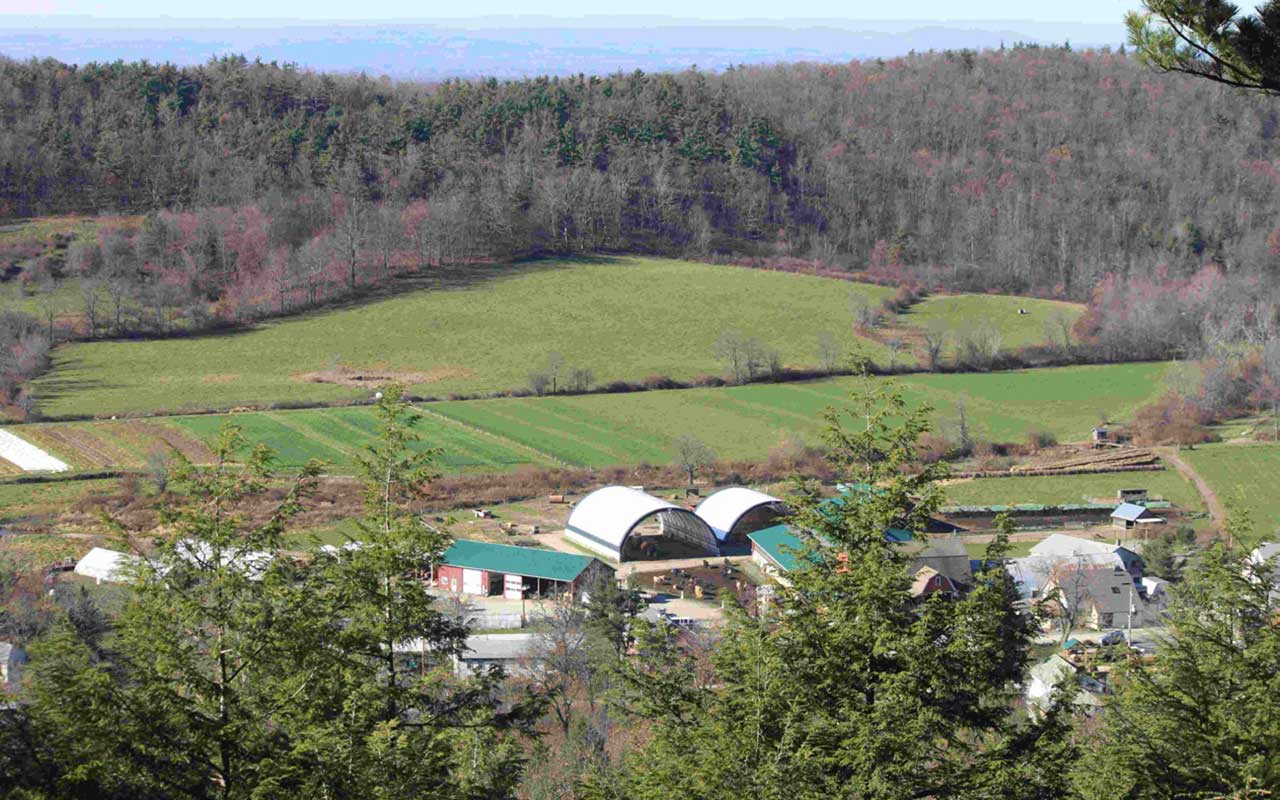This Month’s Featured Article

HAWTHORNE VALLEY FARMSCAPE ECOLOGY PROGRAM – THE SPACE BETWEEN
Columbia County’s landscape is represented by farming and nature. We tend to look at those twin features of the area as distinct, separated by fences, stone walls, and field borders. Where the corn stops is the end of the farm, and where the trees start is the beginning of the woods. Yet, the animals, insects, trees, and plant life don’t see things quite that way.
Working to expose the permeable and overlapping borders of farmland, meadow, woodland, and wetland is the Farmscape Ecology Program.
FEP is one of several programs of Hawthorne Valley Association, an umbrella nonprofit organization founded in 1971 by Waldorf teachers and fashioned in the tradition of Rudolf Steiner. Located in Ghent, NY, HVA promotes social and cultural renewal by integrating agriculture, education, and the arts. It comprises Hawthorne Valley Farm, including an organic CSA, dairy, and farm store; a K-12 Waldorf School; a place-based learning center offering children’s programming on the farm; FEP; and several other initiatives.
Having just celebrated its 20th anniversary in 2023, FEP has grown from two part-time volunteers and borrowed desk space to a six-person team and a cadre of seasonal interns headquartered in its dedicated building on HVA property.
Blurring the lines
Two of the coordinators, Conrad and Claudia Vispo, have been at the helm of FEP since the beginning. Partners in work and life, they complement each other with PhDs in wildlife ecology and land resources. They share a fascination for FEP’s dedication to the space between – between field and farm, animal and plant, insect and amphibian, past and future. The third FEP coordinator, Anna Duhon, who is a social scientist, joined them in 2008.
To stay in that space between worlds takes a certain kind of constitution. Both Conrad and Claudia have a calm and reflective demeanor. They are comfortable with existing in a place that is neither one thing nor another but many things at once. These are requirements for the work they do as ecologists whose goals include understanding the borders that occupy the natural and agricultural landscape of Columbia County.
Occupying the middle ground
Woven through the work of FEP is the “ecology of the middle ground,” which encompasses land that is “neither completely dominated by human hand nor in pristine wilderness.” This characteristic defines much of Columbia County. Humans are part of this ecology, and our decisions ripple into the animal and plant communities we coexist with. FEP is all about the middle ground and urges us to be as well.
FEP strives to conduct research relevant to people and the land around them. Their research and associated outreach provide ways for the community to interface with the local landscape.
They outline three questions that guide their work: What do farms provide for nature? Conversely, does native biodiversity influence farming? Lastly, how can we catalog the biodiversity of that shared landscape?
Additionally, FEP’s work on land use history explores how land was used in the past, how it’s used now, and how it might be used in the future, depending on the decisions we make today.
Habitat exploration
Next month, Black Dome Press will publish The Ecological and Cultural Field Guide to the Habitats of Columbia County, New York, which is the culmination of many years of research by FEP and their colleagues at Hudsonia Ltd. The research involved visits to 500 sites, including forests, old forests, meadows, and wetlands to assess the biodiversity existing within each site. The guide also draws upon countless interviews and focus groups to uncover how people value the land around them and their aesthetic appreciation of it.
Habitats are defined as a community of different types of organisms that self-select into areas of the landscape. These landscapes have vegetative and geographical conditions to satisfy species-specific needs for food, shelter, reproduction, and interrelationships with other species. They are the cornerstone of native species conservation – destroy the habitat, destroy the species.
The field guide explores how to identify habitats, maps of public areas where you can engage with those habitats, an inventory of plant and animal species you can expect to find, suggestions on how to steward these habitats, a history of the habitat overlaid with human history, perspectives on the habitat derived from interviews and public feedback, and suggestions for how one might interact with the habitat.
Tying into their middle ground philosophy, the guide describes not only wilder habitats but also cultivated ones, as a way of emphasizing that all parts of our landscape are habitat for certain species.
Like much of FEP’s work, the guide is not one thing or another but a combination of many things – scientific discovery, historical analysis, field guide, and exploration of the human experience in relation to the habitat in which people live. After all, we are part of the habitat. We occupy space in the natural world, and our actions have an impact on it.
Looking back in time, the guide helps document how we have interacted with the land in the past, and looking forward, it encourages people to think about their contribution (or depletion) to the landscape as it exists today. It also explores the different human perspectives that influence how that habitat is perceived and used.
Agroecology
Farmland doesn’t end at the property line or fence post. There is a blurring of boundaries between the field and the forest. What happens there is in keeping with FEP’s study of that liminal space. This is one aspect of agroecology.
Their projects at the Hudson Valley Farm Hub allow them to experiment on land plots with different vegetation types: seeded wildflowers, seeded native grasses, and whatever grows without seeding (but with an otherwise similar management regime).
The research aims to determine if wildflowers planted in farm fields or surrounding areas can influence the number and diversity of “beneficials,” the “good bugs” such as bees, parasitoid wasps, and ladybugs, that benefit pollination and help control pests.
FEP performs similar work on land where forest borders planted fields, also known as the “edges,” to see if insects journey from woodland to planted environment or vice-versa. This is an explicit effort to describe how porous the farm/non-farm borders are.
The magic of mushrooms
Mushrooms are new to the FEP data collection. FEP’s botany technician, Josie Lang, has been cataloging the fungi she found at Hawthorne Valley and in the surrounding Columbia County. Her work in progress provides images and descriptions on the FEP website, and she has been documenting her findings on iNaturalist.
Misunderstood wasps and ants
One group of beneficial insects of particular interest to Kendrick Fowler, FEP’s entomology lab manager, is parasitoid wasps. These solitary and often relatively tiny wasps feed on their host as they grow, ultimately killing it. Of interest to FEP is that some of these wasps feed on “bad” bugs that damage crops. The wasps perform a valuable yet hard-to-calculate ecosystem service and contribute to reducing the number of insects harmful to crops.
Another small but mighty insect that plays a vital role in agriculture is the humble ant, which is the subject of study for FEP’s conservation biologist Kyle Bradford, who observes ant behavior and is on the prowl for rare ant species – two of which have been documented at Hawthorne Valley Farm in lightly managed, dry pastures.
Public engagement
The FEP website is brimming with information, photos, resources, and maps to help community members engage with Columbia County. Throughout the year, FEP hosts presentations, workshops, and guided walks through the surrounding area. All its events present the natural environment up close and personal. The FEP team is adept at taking the significance of those minute observations and marrying them to the larger implications for the natural community in which we live.
Their wonderfully informative blog called Progress of the Seasons Journal is well worth subscribing to. Written in turn by each of the FEP staff, it’s like taking a guided nature hike from the comfort of your armchair. The blogs are newsy, conversational, observational, and scientific. They are the next best thing to being there.
Reading about the wonders of nature may one day motivate you to follow in the footsteps of Claudia, Anna, Josie, Kendrick, Kyle, and Conrad and see Columbia County through their eyes. It’s a county of farm fields and forest in a relationship, small miracles making their way through the soil, complexities of the edges on full display, and opportunities for we humans to learn how to be good neighbors – without the good fences. •
For more information about the Farmscape Ecology Program, visit hvfarmscape.org. To learn about the work of the Hawthorne Valley Association go to hawthornevalley.org.



